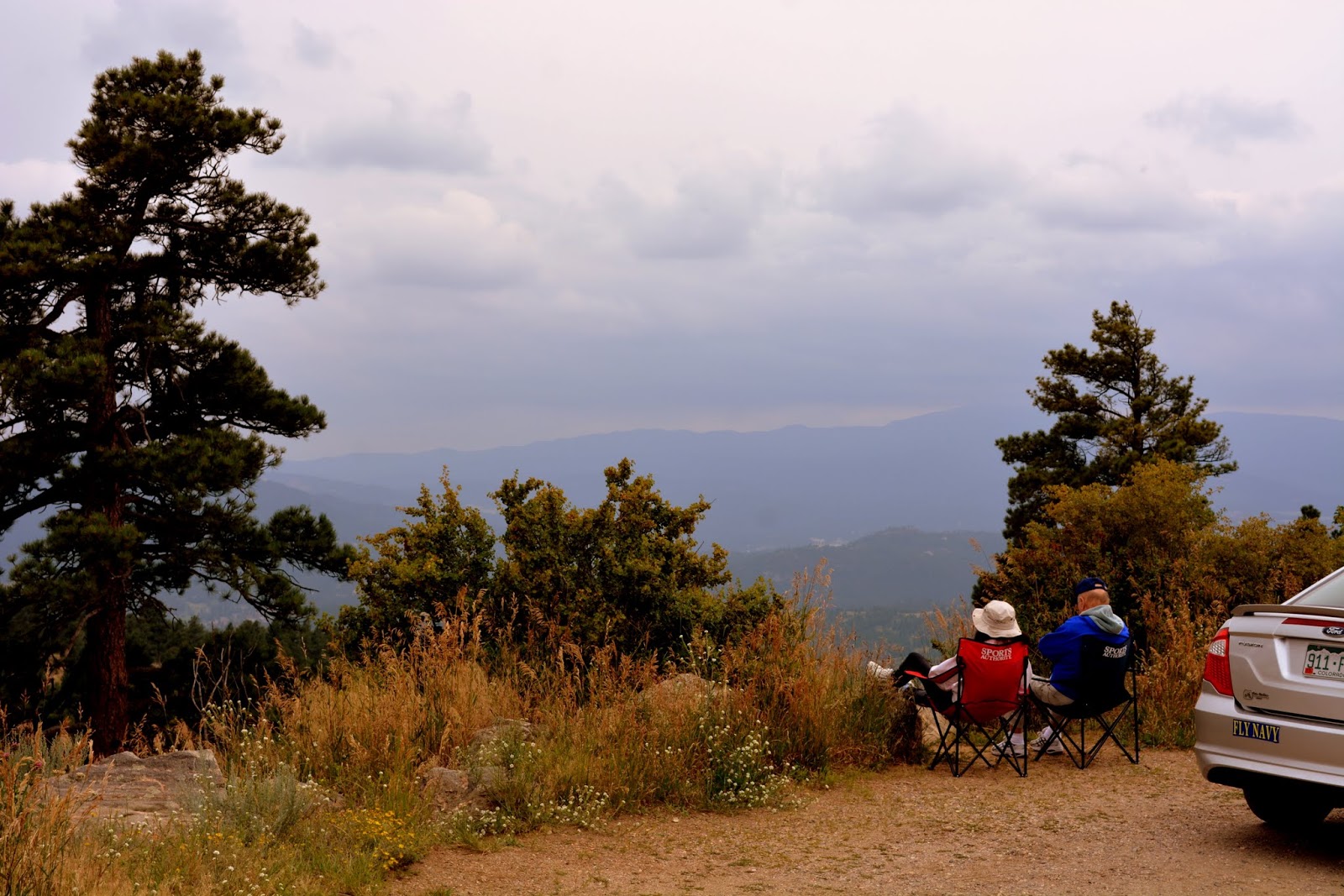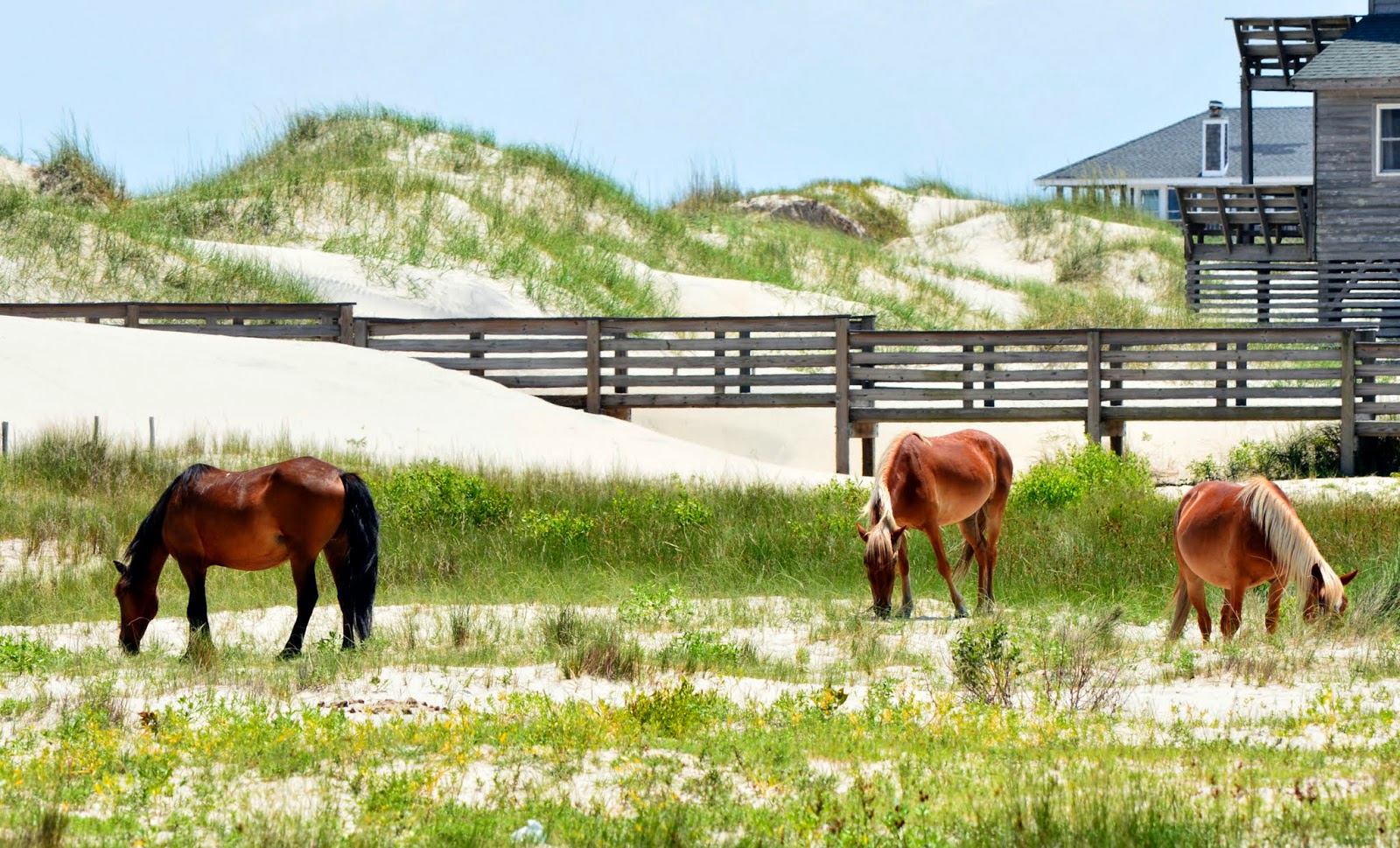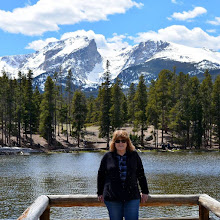My family enjoyed a vacation in the town of Corolla, in the Outer Banks, of North Carolina in July--to see more about the house we rented, and the special occasion we celebrated during that week,
click here. We also participated in many fun and interesting activities that week and visited some wonderful historic sights. I could make a blog post about each one, but I combined them here in a condensed version in order to return to blogging about Colorado very soon. I hope you'll enjoy this vacation look back--photo-rich, I promise!
One of the activities we enjoyed with our grandchildren was a wild horse tour in a large Hummer 4WD Vehicle! There are many wild horse tours to chose from, and unless you are driving a 4WD vehicle while staying on the Outer Banks (also known as the OBX), it is the only way to enter the most northern part of Corolla, on
Carova Beach, which is designated as a "4WD Vehicle Only" accessible beach.
(All photos and photo collages in this blog post will enlarge for easier viewing if they are clicked on)
As you can see by the first photos going across the upper portion of the photo collage above, this portion of the Outer Banks is separated by protective fencing, that keeps the wild horses on this part of the island in a natural 7,500-acre sanctuary. This part of the OBX is more secluded, and less populated, has less traffic, and has no stores or restaurants. The horses are descendants of the mustang
wild horses that were brought to the islands by Spanish and possibly, English, explorers around 500 years ago. When you glance at them for the first time, their beauty and grace will take your breath away!
It is advised that viewers of the wild horses remain 50 feet distance and do not feed them under the penalty of a fine.
The Corolla Wild Horse Fund has been set up with the mission to protect, conserve and manage the horses that roam freely on this part of the island.
Quite a few had local birds riding on their bacs!
The horses find water in freshwater ponds inland, and this is an excellent place to find them in small herds. They eat native grasses and flowers. The weather is temperate here all year round, so they usually have no problem finding enough native food to eat.
The horses are significantly smaller than modern varieties, with an average height of about 14 feet tall. They are all shades of brown, from honey to almost black chocolate, with thick manes.
If you ever visit the Outer Banks a visit to see the wild horses is definitely something you should do!
I love visiting lighthouses, and the Outer Banks barrier islands have five of them! I was fortunate enough to see three of the five. The first lighthouse was located only a mile and a half away from the house we rented, and my husband and I took a walk over to see it one morning.
The Currituck Beach Lighthouse was built in 1875 and is located between the Cape Henry Lighthouse and the Bodie Island Lighthouse. It was the last brick lighthouse built in the Outer Banks, and the only one left unpainted. The Currituck Beach Lighthouse is known as a first-order lighthouse, as it has the largest of seven Fresnel lens sizes. With a 20-second flash cycle, the light can be seen for 18 nautical miles. The distinctive sequence enables the lighthouse not only to warn mariners but also help identify their locations. There are 214 steps inside to the top galley platform, and if you look closely at my photo you can see the line of people waiting to walk to the top! We did not do the climb, as we wanted to walk around the nearby
Historic Corolla Village and see the sights there.
Also called a Light Station, Bodie Island Lighthouse
is the third lighthouse to be constructed at this location, as the first was abandoned due to a poor structure and the second was destroyed by the retreating Confederate Army during the Civil War. Constructed in 1872, it had a first-order Fresnel lens and was manned until 1940 when it was completely automated. It is located on Roanoke Sound, north of Oregon Inlet, south of Nags Head, at 156 feet, it is one of only a dozen surviving brick tower type lighthouses in the US. It was also open to climbing--214 steps to the top!
As my husband and I drove over 84 miles south towards Cape Hatteras (almost two hours driving time) we passed through the beautiful areas of
Pea Island National Wildlife Refuge, and the
Cape Hatteras National Seashore. Both are areas I would love to explore further if we return to the Outer Banks in the future! The ride was very scenic and I enjoyed snapping photos as we drove along.
I was especially excited to see the Cape Hatteras Lighthouse
, as I remembered reading about how it was moved inland in 1999, in order to save it from beach erosion. When it was built it stood 1,500 feet from the ocean. By 1999, the lighthouse was within only 100 feet of the ocean! To protect it, it was moved inland 2,900 feet, over a 23 day period. You can read more about that engineering feat at this
NPS link, and see an interesting YouTube video about the move at
this link.
The Cape Hatteras Lighthouse protects one of the most hazardous sections of the Atlantic Coast. Offshore of Cape Hatteras, the Gulf Stream collides with the Virginia Drift, a branch of the Labrador Current from Canada. This current forces southbound ships into a dangerous twelve-mile long sandbar called the Diamond Shoals. Hundreds, and possibly thousands, of shipwrecks in this area have made it known as the "
Graveyard of the Atlantic."
Constructed in 1870, the Cape Hatteras lighthouse was also the third lighthouse constructed in this sight, with the first two found to be insufficient and destroyed. At 210 feet high, it is the highest all brick lighthouse in America! Inside is a spiral staircase of 248 steps, and a climb would equal going up to a 12 story building. The public is able to buy tickets to
climb to the top, but we did not do that as we had to return back to Corolla in a timely manner to get ready for my son and daughter-in-law's
tenth wedding anniversary vow re-newel ceremony that was taking place that afternoon.
Another favorite outing we had with the entire family was a boat ride--the Bodie Island Dolphin Tour! We passed many magnificent homes along the wetland shores of Pirates Cove in this area until we were well out into the Roanoke Sound. It was fun to watch the bottleneck dolphins swim and frolic in the water. We also saw nesting ospreys. herons, egrets and brown pelicans along our ride. The boat ride was so relaxing our younger grandson fell asleep on the way back to the dock. Afterward, we went to an "all you can eat" seafood restaurant in the area and indulged on wonderfully fresh seafood. It was the perfect day!
I would have been remiss to not have visited the
Wright Brothers National Memorial on my visit to the Outer Banks. Located in Kill Devil Hills, this area marks the spot where Wilbur and Orville Wright, after four years of experimentation and dreaming, achieved their first successful flights in 1903! The site has an interesting visitors center where the story of the Wright brothers and their dream of flight is explained, and models of their first glider and the first powered aircraft in history to maintain a sustained flight, are located. The original airplanes are located in the
National Air and Space Museum in Washington, DC.
We listened to an informative Ranger talk about the Wright brothers and enjoyed all the exhibits inside the visitor center. Outside, on the hill the brothers used to help the winds help them take flight, is a 64-foot granite monument dedicated to them in 1932. Atop the monument is a marine beacon, similar to one found in a lighthouse. Also, along the grounds are granite markers that show the date and distance of each of their successful flights.
The collage above shows the distance from Kill Devil Hill to the first successful flight marker. There are four markers in the field that show the distance of all four flights the Wright brothers made on Dec 17, 1903. The last of which is the historic fourth flight, of 852 feet of flight in 59 seconds, with Wilbur as the pilot. It proved that the aircraft could be controlled and sustained in a "heavier than air" machine, which opened the door to future aeronautic discoveries!
This is the monument on top of Kill Devil Hill with tributes to both
Wilbur and
Orville Wright located on either side of it.
This is the view looking down from the hill towards the flight markers, the airplane hanger and house the Wright brothers stayed in when they experimented with their flights on December 17, 1903, and the Memorial's Visitor's Center. There is also a nice view of the
Kill Devil Hills community and the Atlantic Ocean from atop the hill. Most people associate the Wright brothers with the town of
Kitty Hawk, as that is the town where news of their successful flight was sent out to the world.
The
Wilbur and
Orville Wright--"They Taught Us To Fly" memorial plaque located on the National Memorial grounds. I love to fly, and it was thrilling to pay homage to the men that began it all in the last century!
A last look at more of the happy memories we now have of the Outer Banks of North Carolina. I hope you also enjoyed your armchair visit to many of the attractions of this beautiful area of the United States. Someone asked me if I missed living near the seashore, and I have to admit I miss the availability of all the fresh seafood one can find in New York City and all along the east coast, but I am now in love with the Rocky Mountains and all the beauty I've seen in Colorado. I have much to show in future blog posts about what we have been doing this summer in our wonderful new state!
You can also find me on







































.jpg)

























































